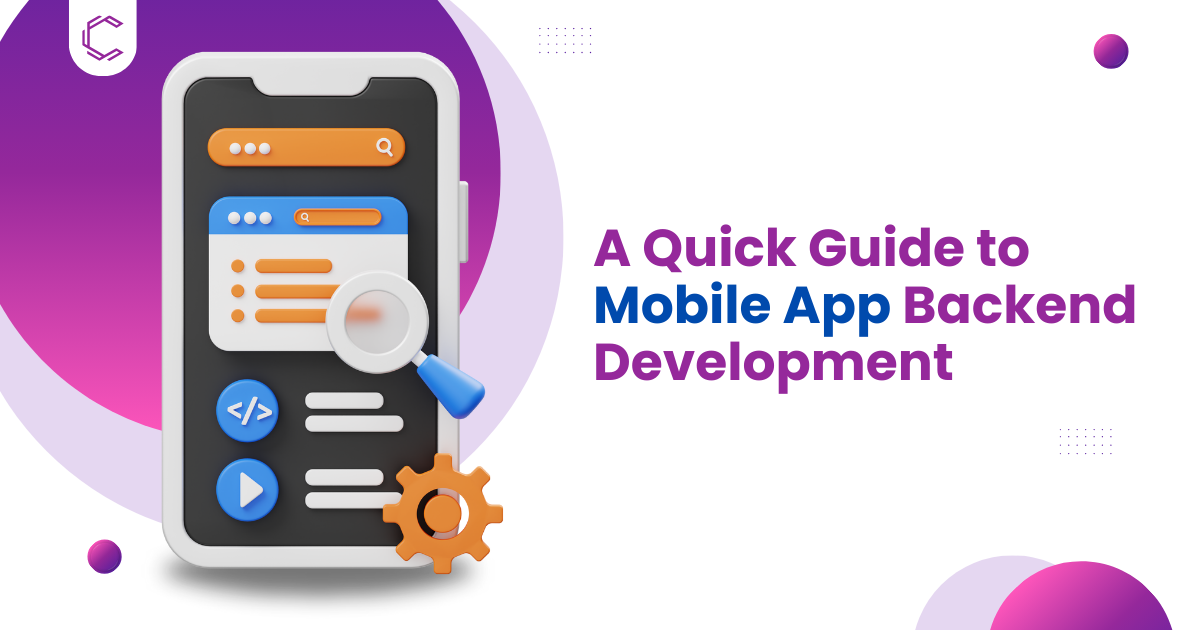Creating a successful mobile app is about much more than an attractive interface and easy navigation. Behind every high-functioning mobile app is a robust backend that powers its features, manages data, and ensures a smooth user experience. Mobile app backend development is the hidden powerhouse that enables an app to function effectively. For developers, business owners, and tech enthusiasts alike, understanding the essentials of backend development is key to building an efficient app that performs well and meets user expectations.
In this guide, we’ll cover the basics of mobile app backend development, explore different backend components, discuss popular technologies and tools, and highlight best practices to follow. Whether you’re planning to develop an app or simply want to know more about what makes your favorite apps work, this article will give you a clear, jargon-free overview of mobile app backend development.
What is Mobile App Backend Development?
The backend of a mobile app is the server-side part that users don’t see but is critical for functionality. The backend handles data storage, authentication, business logic, and server-side processing. It essentially serves as the “brain” of the app, managing everything from database interactions to user authentication and communication with external services.
In mobile app development, the frontend is what users interact with directly—the buttons, forms, and screens. The backend, on the other hand, is responsible for everything that goes on behind the scenes, including retrieving and storing data, processing user inputs, and enabling seamless functionality across various devices.
Key Components of Mobile App Backend
1. Database
A database stores all the data an app needs to function, including user information, settings, transaction histories, and more. For mobile apps, databases should be fast, secure, and scalable. Popular choices include MySQL, PostgreSQL, and MongoDB.
2. Server
The server is where the backend code resides and runs. When users interact with the app, requests are sent to the server, where they are processed, and responses are sent back. This two-way communication enables the app to fetch data, update information, and deliver results. Servers can be self-hosted, or developers can use cloud servers like AWS, Google Cloud Platform (GCP), or Microsoft Azure.
3. API (Application Programming Interface)
APIs are crucial for enabling the frontend and backend to communicate. APIs allow different software components to interact, enabling data exchange and functionality access. For mobile apps, RESTful APIs and GraphQL are popular choices. They allow data to flow seamlessly between the app interface and backend systems.
4. Authentication and Authorization
Authentication is the process of verifying user identity, while authorization determines what an authenticated user is allowed to do within the app. Implementing secure login methods like OAuth, JWT (JSON Web Tokens), or two-factor authentication (2FA) is essential for protecting user data and providing a safe user experience.
5. Business Logic
The business logic layer handles the core functionalities and operations of the app, including data processing, decision-making, and user-specific functionality. Business logic ensures that the app operates according to the specific rules and goals of the business, such as purchase processing in an e-commerce app or data management in a social media app.
6. File Storage
File storage is often required for apps that handle multimedia files, such as photos, videos, or documents. Cloud storage solutions like AWS S3, Google Cloud Storage, and Firebase Storage are commonly used for reliable and scalable file storage.
Types of Mobile App Backends
1. Custom Backend
A custom backend is tailored specifically to the app’s requirements. Developers have complete control over the structure, components, and logic, allowing for maximum flexibility. However, custom backends can be complex and time-consuming to build.
2. BaaS (Backend as a Service)
Backend as a Service (BaaS) provides pre-built backend components and infrastructure. BaaS platforms like Firebase, Parse, and Backendless handle data storage, user authentication, and other backend functions, allowing developers to focus on front-end development. BaaS is ideal for startups or developers looking for a faster setup with minimal backend management.
Popular Technologies for Mobile App Backend Development
1. Node.js
Node.js is a JavaScript runtime popular for building scalable, high-performance backends. Its asynchronous, event-driven architecture is ideal for real-time applications like chat apps, gaming, and collaborative tools.
2. Python with Django or Flask
Python frameworks like Django and Flask are widely used for backend development. Django provides a “batteries-included” approach with built-in tools for handling user authentication, database management, and more, while Flask offers a lightweight, flexible approach for developers who need more control.
3. Ruby on Rails
Ruby on Rails, often simply called Rails, is known for its simplicity and rapid development capabilities. It is an ideal choice for building applications with a strong emphasis on CRUD operations (Create, Read, Update, Delete).
4. Java with Spring Boot
Java is a time-tested language used by many financial, healthcare, and enterprise applications. The Spring Boot framework simplifies backend development in Java, making building secure and efficient applications easier.
5. PHP with Laravel
PHP and the Laravel framework remain popular for backend development, especially for web and mobile applications requiring quick, robust solutions. Laravel’s ecosystem includes tools for handling database migrations, authentication, and testing.
Key Considerations in Mobile App Backend Development
1. Scalability
Scalability is crucial for backend systems, especially as an app grows. Whether using a custom backend or a BaaS provider, the backend must handle increasing numbers of users and requests without compromising performance. Cloud services like AWS Lambda and Google Cloud Functions offer scalable serverless options.
2. Security
Security is paramount in backend development, especially when handling sensitive user data. Implementing SSL/TLS encryption, data protection measures, and secure APIs can prevent data breaches and protect user privacy.
3. Performance Optimization
Performance optimization ensures that data retrieval, processing, and responses happen quickly. Techniques like caching, database indexing, and load balancing can drastically improve performance, providing a smooth user experience even under high traffic.
4. Data Management and Backup
Having a proper data management and backup strategy is essential for data reliability and disaster recovery. Regular backups, redundancy, and data synchronization can prevent data loss and ensure data is always available.
5. Maintenance and Updates
Regular maintenance and updates are essential for keeping the backend running smoothly. Regular code reviews, security patching, and updates help maintain efficiency, security, and functionality.
Steps to Build a Mobile App Backend
Step 1: Define Requirements and Goals
Start by defining the goals and requirements for your app’s backend. Consider the type of data, user management needs, scalability requirements, and any unique functionalities.
Step 2: Choose the Right Technology Stack
Select a technology stack based on your app’s goals and resources. Consider languages, frameworks, and hosting options that align with your requirements.
Step 3: Set Up Database and Server
Decide on a database type (SQL or NoSQL) and set up the server environment. Choose a server provider like AWS, Google Cloud, or Azure based on scalability and budget needs.
Step 4: Develop APIs and Business Logic
Develop APIs to handle the communication between the frontend and backend. Write the business logic that will process data, handle operations, and ensure smooth interactions within the app.
Step 5: Implement Authentication and Security
Set up secure user authentication and authorization methods. Implement additional security layers like SSL certificates, data encryption, and two-factor authentication.
Step 6: Test and Deploy
Before deployment, thoroughly test the backend to identify and resolve any issues. Testing helps ensure that the backend is reliable, secure, and performs optimally.
Step 7: Monitor and Optimize
After deployment, monitor the backend for performance issues. Use monitoring tools to track uptime, latency, and error rates, and make necessary adjustments for continuous improvement.
Tools for Mobile App Backend Development
- Firebase: Offers real-time database, authentication, and analytics for quick backend solutions.
- AWS Lambda: Provides serverless computing that automatically scales and adjusts to demand.
- Docker: Containerization tool that simplifies deployment and makes the backend easily portable.
- Postman: An API testing tool that makes it easy to design, test, and debug APIs.
- Jenkins: A continuous integration and deployment tool that automates backend updates.
Common Challenges in Mobile App Backend Development
1. Managing Large Data Volumes
Apps that handle extensive data (e.g., social media, video streaming) require an efficient way to process and store this information. Proper database design and data management tools are crucial for smooth performance.
2. Ensuring Compatibility with Multiple Devices
Mobile apps run on different devices and operating systems. The backend must be compatible with iOS, Android, and other platforms to provide a consistent experience for all users.
3. Handling Real-Time Updates
Apps that require real-time data, like messaging and gaming apps, need a backend that can support instant data processing. Technologies like WebSockets and Firebase Realtime Database can help manage real-time needs.
4. Balancing Speed and Security
Fast response times are crucial for user experience, but security cannot be compromised. Balancing these two aspects requires efficient code, secure architecture, and performance optimizations.
Conclusion
Mobile app backend development is the backbone of a well-functioning, scalable, and secure app. From setting up databases and servers to implementing business logic and security, the backend plays a critical role in an app’s success. Choosing the right technology stack, prioritizing security, and ensuring scalability are essential for building a robust backend.
Whether you’re developing an app in-house or working with a mobile app backend development company, understanding backend fundamentals will help you create a solution that meets user expectations and performs efficiently. As the mobile app landscape evolves, staying informed about backend development best practices and emerging technologies will be key to creating apps that thrive in today’s competitive market.




